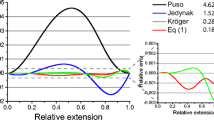Abstract
Density functional theory is used to describe the phase behaviors of rigid molecules. The construction of the kernel function is discussed. Excluded-volume potential is calculated for two types of molecules with C 2v symmetry. Molecular symmetries lead to the symmetries of the kernel function and the density function, enabling a reduction of configuration space. By approximating the kernel function with a polynomial, the system can be fully characterized by some moments corresponding to the form of the kernel function. The symmetries of the kernel function determine the form of the polynomial, while the coefficients are determined by the temperature and molecular parameters. The analysis of the impact of coefficients helps us to choose independent variables in the moments as order parameters. Combining the analysis and some simulation results, we propose a minimal set of order parameters for bent-core molecules.
Similar content being viewed by others
References
Bisi F, Rosso R, Virga E G. Polar steric interactions for V-shaped molecules. Phys Rev E, 2008, 78: 011705
Bisi F, Virga E G, Gartland E C, et al. Universal mean-field phase diagram for biaxial nematics obtained from a minimax principle. Phys Rev E, 2006, 73: 051709
Carnahan N F, Starling K E. Equation of state for nonattracting rigid spheres. J Chem Phys, 1969, 51: 635–636
de Gennes P G, Prost J. The Physics of Liquid Crystals. Clarendon: Clarendon Press, 1993
Fatkullin I, Slastikov V. Critical points of the Onsager functional on a sphere. Nonlinearity, 2005, 18: 2565–2580
Ji G, Wang Q, Zhang P, et al., Study of phase transition in homogeneous, rigid extended nematics and magnetic suspensions using an order-reduction method. Phys Fluid, 2006, 18: 123103
Kim E H, Kadkin O N, Kim S Y, et al. Tetrahedratic mesophases, ambidextrous chiral domains and helical superstructures produced by achiral 1,1′-disubstituted ferrocene derivatives. Eur J Inorg Chem, 2011, 2011: 2933–2941
Li J, Sircar S, Wang Q. Transient rheological responses in sheared biaxial liquid crystals. Rheol Acta, 2010, 49: 699–717
Liu H, Zhang H, Zhang P. Axial symmetry and classification of stationary solutions of Doi-Onsager equation on the sphere with Maier-Saupe potential. Comm Math Sci, 2005, 3: 201–218
Lubensky T C, Radzihovsky L. Theory of bent-core liquid-crystal phases and phase transitions. Phys Rev E, 2002, 66: 031704
Maier W, Saupe A Z. Eine einfache molekulare theories des nametischen kristallinflüssigen Zustandes. Naturforsch, 1958 A13: 564–566
Matteis G D, Romano S, Virga E G. Bifurcation analysis and computer simulation of biaxial liquid crystals. Phys Rev E, 2005, 72: 041706
Matteis G D, Sonnet A M, Virga E G. Landau theory for biaxial nematic liquid crystals with two order parameter tensors. Continuum Mech Thermodyn, 2008, 20: 347–374
Matteis G D, Virga E G. Tricritical points in biaxial liquid crystal phases. Phys Rev E, 2005, 71: 061703
Mayer J E, Mayer M G. Statistical Mechanics. New York: John Wiley & Sons, 1940
Mulder B M. The excluded volume of hard sphero-zonotopes. Mol Phys, 2005, 103: 1411–1424
Onsager L. The effects of shape on the interaction of colloidal particles. Ann N Y Acad Sci, 1949, 51: 627–659
Rosso R, Virga E G. Quadrupolar projection of excluded-volume interactions in biaxial nematic liquid crystals. Phys Rev E, 2006, 72: 021712
Schneider R. Convex bodies: The Brunn-Minkowski Theory. In: Encyclopedia of Mathematics and its Applications, vol. 44. Cambridge: Cambridge University Press, 1993
Sircar S, Li J, Wang Q. Biaxial phases of bent-core liquid crystal polymers in shear flows. Comm Math Sci, 2010, 8: 697–720
Sircar S, Wang Q. Shear-induced mesostructures in biaxial liquid crystals. Phys Rev E, 2008, 78: 061702
Sircar S, Wang Q. Dynamics and rheology of biaxial liquid crystal polymers in shear flow. J Rheol, 2009, 53: 819–858
Sonnet A M, Virga E G, Durand G E. Dielectric shape dispersion and biaxial transitions in nematic liquid crystals. Phys Rev E, 2003, 67: 061701
Starley J P. Ordered phases of a liquid of biaxial particles. Phys Rev A, 1974, 10: 1881–1887
Takezoe H, Takanishi Y. Bent-core liquid crystals: their mysterious and attractive world. Jpn J Appl Phys, 2006, 45: 597–625
Zhou H, Wang H, Forest M G, et al. A new proof on axisymmetric equilibria of a three-dimensional Smoluchowski equation. Nonlinearity, 2005, 18: 2815–2825
Author information
Authors and Affiliations
Corresponding author
Rights and permissions
About this article
Cite this article
Xu, J., Zhang, P. From microscopic theory to macroscopic theory — symmetries and order parameters of rigid molecules. Sci. China Math. 57, 443–468 (2014). https://doi.org/10.1007/s11425-013-4761-3
Received:
Accepted:
Published:
Issue Date:
DOI: https://doi.org/10.1007/s11425-013-4761-3




